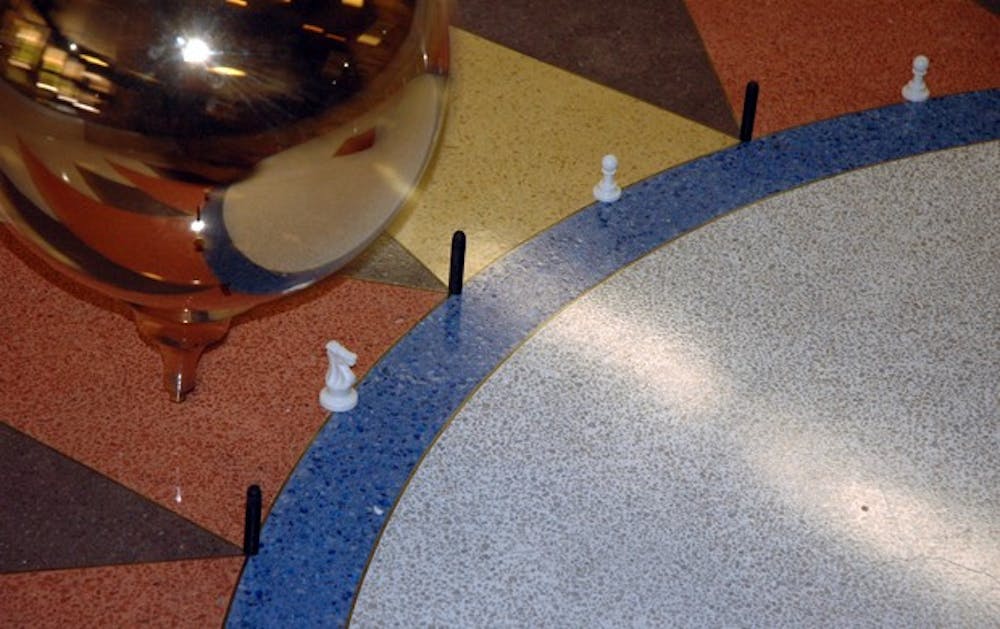Depending on your major, you may have caught it, and you might not have: suspended delicately by a thin wire a burnished bronzed ball roughly the size of a basketball swings slowly back and forth. Its graceful arc traces a circle, ponderous and undetectable until it nudges a chess piece and knocks it over.
Students in the Bateman Physical Sciences F-wing mill at the foyer between classes, the glass-encased Foucault Pendulum is a constant presence – well, a moving, constant presence. Occasionally you might catch a student stopping to stare, mesmerized by the pendulum’s endless motion.
Six stories above professor Edmund Stump of the School of Earth and Space Exploration walks past the receptionist and stops by the copy machine. “I have a master key,” he says with a smile, unlocking a door. The four-by-four closet conceals the top of the pendulum, shuddering past an electromagnet. Looking straight down, the magnified arc of the pendulum can be seen brushing against the pegs encircling it.
The Foucault Pendulum at ASU was installed in 1976, when the building was built and is a colorful part of the department’s history. At the time the physics department was on the bottom of the Bateman building, and the geology department on the upper floors.The pendulum is attached to the Robert S. Dietz Museum of Geology.
“There was a funny line at the time: ‘Geology got the pendulum and physics got the shaft,’” Stump says laughing.
When the pendulum was installed, its swing had to be fine-tuned. Troy Péwé, head of the geology department, and former head Paul Miller took a two-foot monkey wrench up to the sixth floor closet to tackle the contraption. Wearing white shirts and ties the two twisted bolts around until it swung straight. A steady swing ensures that the pendulum demonstrates the principle of physics it was intended to.
The half-standing, half-knocked over pieces around the pendulum – chess pieces, pegs, plastic dinosaurs – trace the rotation of the Earth, capturing “the spirit of the demonstration,” says Gary Adams, physics professor and Ph. D., through email.
Imagine yourself standing at the North or South Pole. Now hang a pendulum, basically a string with a weight attached, directly over the pole and set it in motion. The pendulum swings in a fixed plane. It does not move side to side or suddenly change direction; it traces out a straight arc. At the poles, it’s easy to imagine the Earth rotating in a circle beneath the pendulum, and if dominoes are set up in a circle around the pendulum, in roughly 24 hours all of them will have been pushed over by the swinging weight.
At latitudes other than the poles or the Equator, the story is a little more complicated: Pendulums at all other latitudes rotate with respect to an inertial frame. Eyes crossed yet? Bear with me. Remember from high school physics that a body in motion tends to stay in motion. That’s the principle that allows the Foucault Pendulum to work.
Where the pendulum at ASU swings the latitude is 33º 25.5’. Start the pendulum swinging in a north-south direction and it will stay swinging north to south direction relative to the Earth’s position when you started the pendulum because of inertia. Still confused? Let’s try something else.
Put a globe in front of you. Find Arizona and karate chop it with your hand from the North Pole to the South Pole. Now don’t move your hand from this position. Turn the globe keeping your hand at the same angle that you started with and notice how the globe rotates under your hand. You can’t turn the globe all the way around and keep your hand in position without disjointing your wrist and becoming a circus act, but you get the idea. The line your hand makes represents inertia, and relative to your body it stays in the same direction, but relative to the globe, it moves in a circle.
In 1851, French scientist Jean Foucault used a large pendulum to demonstrate this principle and prove that the Earth spins. An exact copy of his pendulum swings in the Panthéon in Paris today.
The pendulum at ASU is cared for by Wendy Taylor, assistant director of the Dietz museum, and geology major Devon Baumback. They are responsible for setting up the pieces that the pendulum knocks over. Passersby will notice plastic dinosaurs, aliens, Stonehenge and chess pieces among the figurines that are toppled.
“The more we change it the more attention it gets,” Taylor says.
The pendulum does grab attention from students and staff, but it’s not perfect. Air resistance causes the pendulum to gradually slow, which is why there is an electromagnet at the top: to give it an extra kick. Occasionally, though, the pendulum does come to a standstill.
“If we get carried away and put something too big in there and it gets caught, it will stop,” Baumback says. “We grab it with the hook and pull it.”
Despite the pitfalls of friction, the Foucault Pendulum at ASU keeps swinging, an example of the continuous commitment the faculty, staff and students have for their field of work.
Contact the reporter at klhwang@asu.edu






